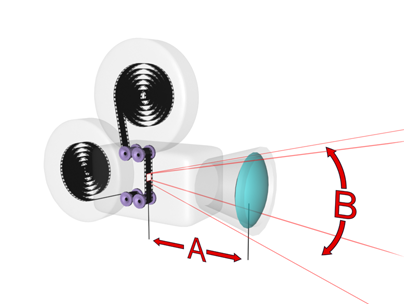Real-world cameras use lenses to focus the light reflected by a scene onto a focal plane that has a light-sensitive surface.

Real-world camera measurements.
A: Focal length
B: Field of view (FOV)
The distance between the lens and the light-sensitive surface, whether film or video electronics, is called the focal length of the lens. Focal length affects how much of the subject appears in the picture. Lower focal lengths include more of the scene in the picture. Higher focal lengths include less of the scene but show greater detail of more distant objects.
Focal length is always measured in millimeters. A 50mm lens is a common standard for photography. A lens with a focal length less than 50mm is called a short or wide-angle lens. A lens with a focal length longer than 50mm is called a long or telephoto lens.
The field of view (FOV) controls how much of the scene is visible. The FOV is measured in degrees of the horizon. It is directly related to the focal length of the lens. For example, a 50mm lens shows 46 degrees of the horizon. The longer the lens, the narrower the FOV. The shorter the lens, the wider the FOV.
Relationship Between FOV and Perspective
Short focal lengths (wide FOV) emphasize the distortions of perspective, making objects seem in-depth, looming toward the viewer.
Long focal lengths (narrow FOV) reduce perspective distortion, making objects appear flattened and parallel to the viewer.

Upper left: Long focal length, narrow FOV
Lower right: Short focal length, wide FOV
The perspective associated with 50 mm lenses appears normal, partly because it is close to what the eye sees, and partly because such lenses are so widely used for snapshots, news photos, cinema, and so on.
Differences Between Camera Objects and Real-World Cameras
Many other controls on real-world cameras (such as those for focusing a lens, and advancing film) aren’t needed for computer rendering and have no counterpart in the camera objects.
3ds Max does have counterparts for the camera movements used in movie making, such as truck, dolly, and pan. See Camera Viewport Controls.
To match a real-world camera frame proportion:
 Render Setup.
Render Setup.
The Safe Frame proportions will match those of the selected output size.